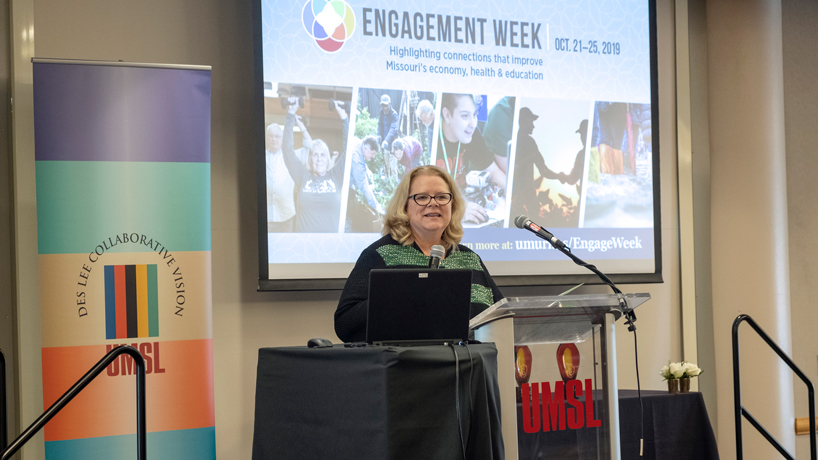
UMSL Interim Chancellor Kristin Sobolik speaks about the many ways people at the university engage with the broader community and work to improve the St. Louis region during a University of Missouri System Engagement Week kickoff event on Monday at the Millennium Student Center. (Photo by August Jennewein)
By Interim Chancellor and Provost Kristin Sobolik
The University of Missouri–St. Louis’ role as a metropolitan land-grant institution is to be an essential partner in generating an educated workforce, enhancing economic development, supporting broad-based service delivery, facilitating neighborhood renewal and fostering inclusion.
This sense of purpose permeates everything we do and has been central to our development as a model anchor institution.
Our devotion to quality instruction and the development of talent ensures that our students – primarily from the St. Louis region – are well prepared for success in and beyond the classroom.
These students come to UMSL from all segments of the community with the goal of becoming leaders in our communities and economy.
The fact that U.S. News and World Report recently included UMSL is its inaugural “Top Performers on Social Mobility” ranking – meaning that the university does an outstanding job of graduating students with extreme financial need – is just one indicator of our success as a community partner.
And with nearly 75,000 alumni living and working locally, UMSL’s diverse graduates are perhaps our greatest contribution to community engagement and economic development.
But they are certainly not our only contributions.
UMSL takes seriously its role as a facilitator and collaborator on projects that improve the conditions of local communities, whether they involve job creation, health care alternatives, neighborhood renewal or K-12 educational enhancements.
- UMSL is a founding partner of the Cortex Innovation Community in midtown St. Louis. Begun more than two decades ago, Cortex today includes 390 companies employing 5,700 people with an annual payroll of nearly $350 million.
- When Express Scripts began looking in 2005 to relocate its headquarters and prescription drug fulfillment operations, UMSL put together a proposal to keep this multi-million company in St. Louis. Today, the Express Scripts headquarters and thousands of jobs are located on our campus. We won them over as a partner – initiating internships, customized graduate degree programs and joint research projects.
- Our College of Optometry operates three clinics in the St. Louis region and a mobile eye center to support optometric training and to provide local residents affordable, high-quality eye care. Realizing that the area around campus lacked other healthcare options, our optometry college built a new facility that now includes primary care physicians from SSM Healthcare.
- Working with community partners, UMSL was able to secure a federal “Great Streets” grant to renovate a major section of Natural Bridge Road in an effort to create a walkable environment conducive to private investments. Last month, we announced that Indianapolis-based Pearl Companies would be developing a $60 million housing/retail complex along Natural Bridge, adjacent to the UMSL South Metro station.
- Thousands of elementary, middle and high school students benefit annually from programs supported by UMSL, such as the Bridge Program, Students and Teachers as Research Scientists, Jennings Senior High School Internship program, Advanced Credit, UMSL-sponsored Charter schools, Studio Schools and the Des Lee Fine Arts Education Collaborative. These programs enhance a student’s ability to matriculate to UMSL or other quality institutions.
Research, innovation, entrepreneurship and problem-solving are other avenues in which this campus builds on its knowledge creation so that it can be transferred and applied in ways that are useful and relevant to society.
- Research grants and expenditures hit $27 million during the past fiscal year – a five-year increase of 60 percent. This is attributable to an engaged faculty – most notably in our Missouri Institute of Mental Health. MIMH is a leader in mental health training, program assessment and working with communities to address opioid addiction and abuse.
- UMSL is a primary partner in the nation’s first-ever accelerator to focus predominantly on energy technologies. Key players in the Ameren Accelerator include Ameren Corporation, UMSL Accelerate and Capital Innovators. This effort involves UMSL faculty and students working alongside industry leaders and entrepreneurs who are driving innovation and new company startups.
- UMSL’s Community Innovation and Action Center has created a Regional Data Alliance involving 150 community partners to collect, analyze and distribute data that can help in collaborative efforts to improve the region.
- UMSL is also a founding member of the Anchor Institution Initiative through the Coalition of Metropolitan and Urban Universities – which is an effort to codify and share the best practices in community engagement. Earlier this year we tapped Karl Guenther to lead to our efforts with the Initiative and to help coordinate engagement efforts across all of our schools and colleges.
UMSL is a great university whose faculty certainly concentrate on the education and success of its students. It’s a primary factor why great faculty choose to come to UMSL. But this campus’ commitment to community engagement is another important consideration, as evidence by our unique Des Lee Collaborative Vision.
Started 25 years ago by philanthropist E. Desmond Lee and Chancellor Emeritus Blanche Touhill, the Collaborative is now a collection of 30 endowed faculty members whose contracts include community engagement among their portfolio of activities.
Community partners include all the major cultural and science institutions in St. Louis as well as dozens of schools and hospitals and area not-for-profit organizations. The Collaborative brings together the best talent for community programs and projects affecting the arts, business, citizenship, healthcare, music, science and much more.
UMSL was created in 1963 as a metropolitan land-grant institution. Our commitment to teaching, research and engagement – serving as an Anchor Institution – has never been stronger nor more evident.
Community engagement is another way in which UMSL transforms lives.
Sobolik helped kick off the University of Missouri System’s Engagement Week on Monday by discussing UMSL’s efforts in the St. Louis region.














